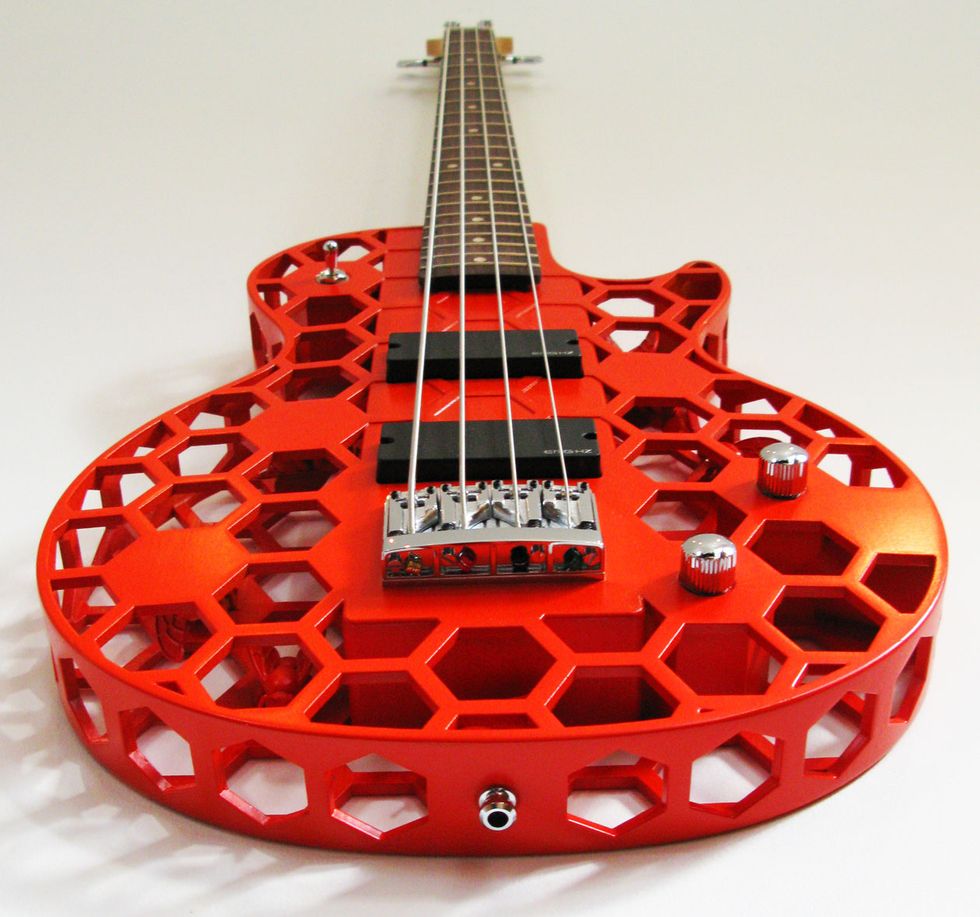In the history of bass and guitar building, wood has, of course, been the main material used for the basic construction of instruments. There have always been luthiers experimenting with alternative materials, but often it's a builder simply wanting an instrument to stand out visually. Sometimes, however, these alternate materials were chosen for a good reason.
Wood is relatively cheap, easy to work with, and has good availability, but it also has its share of properties that can be problematic. Sucking up moisture and reacting to changes in temperature are only two of them. Another thing to consider is wood's dampening effect within the audible spectrum, which leads to vibrational, and therefore tonal, losses. Whether these are dramatic enough handicaps or not comes down to individual opinion, but there's no question these wooden instruments have been the tools for some pretty good music over the years.
Let's take a quick look at some of the alternative materials used for builds, and the motivation and goals of the builders who dared to be different.
As the bass and guitar industry took off during the 1960s, plastic and fiberglass took off, too. These materials were simply everywhere, so why not in guitars? In 1962, Hagstrom and Valco began offering basses with fiberglass bodies, but both companies still incorporated wood for stability reasons. Valco did have the interesting idea to color the resin and bring down production costs by saving on finishing. However, the company learned the hard way how elaborate such a build could be, and went out of business in the late '60s.
Then there was Ampeg's Dan Armstrong bass from 1969. With an acrylic body (Lucite and Plexiglas are just trademark names) and a wooden neck, the company was hoping to keep the weight below the early '60s, all-acrylic showpiece Fender Strat, which weighed in at a whopping 18 pounds. Armstrong was also looking for sustain and reduced dampening, and while they might have reached all these goals, the bass output of the instrument was rather disappointing. There were plenty of mids, but that's about it.
Next up on our material list is aluminum, which appeared in John Veleno's guitars in 1972 and Travis Bean instruments in 1974. While Veleno had an all-aluminum approach, Bean used it for a neck-through design with wooden wings. (We should also give honorary mention to Rickenbacker's Frying Pan, introduced in 1931, but we're not talking lap steels here.) The motivation to use aluminum by these builders isn't completely clear, but it could certainly have been for stability, reduced dampening, weight reduction, and moisture and temperature resistance.
The end of the '70s gave us the first carbon-fiber basses by Ned Steinberger. His main goal was to design an extremely rigid, tuning-stable instrument. Steinberger's design offered lots of other innovative solutions, and it was one of the most successful non-wooden builds of the era.
Since the mid 1990s and 2000s, the market has become far more diverse, in large part thanks to new production methods and new man-made materials. The availability of different composites and compositions helped to create a small market that never really made it into the mainstream, but included interesting combinations with materials like sawdust, glass bubbles, foam, hemp fibers, and recycled granulate from yogurt pots to seized pirated CDs.
In 1997, Ibanez introduced a polymeric material called Luthite, which was later used by another company called Vibracell. Although the patent claims the use of glass bubbles or other inorganic fillers to control gravity and provide better density, the Ibanez instruments remained rather heavy, and production was discontinued in 2006.
When the prices of CNC machinery came down, the market began to see a number of different aluminum models appear—and even a 100-percent stainless-steel bass! A similar thing also happened when 3-D printing hit the mass market, because the technology can work with a huge amount of different basic materials, including all sorts of plastics and metals.
Most of the motivations behind all these alternative-material builds were moisture and temperature resistance, weight relief, and cost reduction, but often were simply attempts to stand out—rarely for any sort of tonal improvement, except maybe the ever-so-important sustain. In my opinion, it seems as if there was a clearer plan behind the early builds with wood alternatives. Today, at times, it appears to have turned into more of a “because we can" attempt, without a clear concept in sight.








![Rig Rundown: AFI [2025]](https://www.premierguitar.com/media-library/youtube.jpg?id=62064741&width=1245&height=700&quality=70&coordinates=0%2C0%2C0%2C0)












 Shop Scott's Rig
Shop Scott's Rig


![Rig Rundown: Russian Circles’ Mike Sullivan [2025]](https://www.premierguitar.com/media-library/youtube.jpg?id=62303631&width=1245&height=700&quality=70&coordinates=0%2C0%2C0%2C0)












































